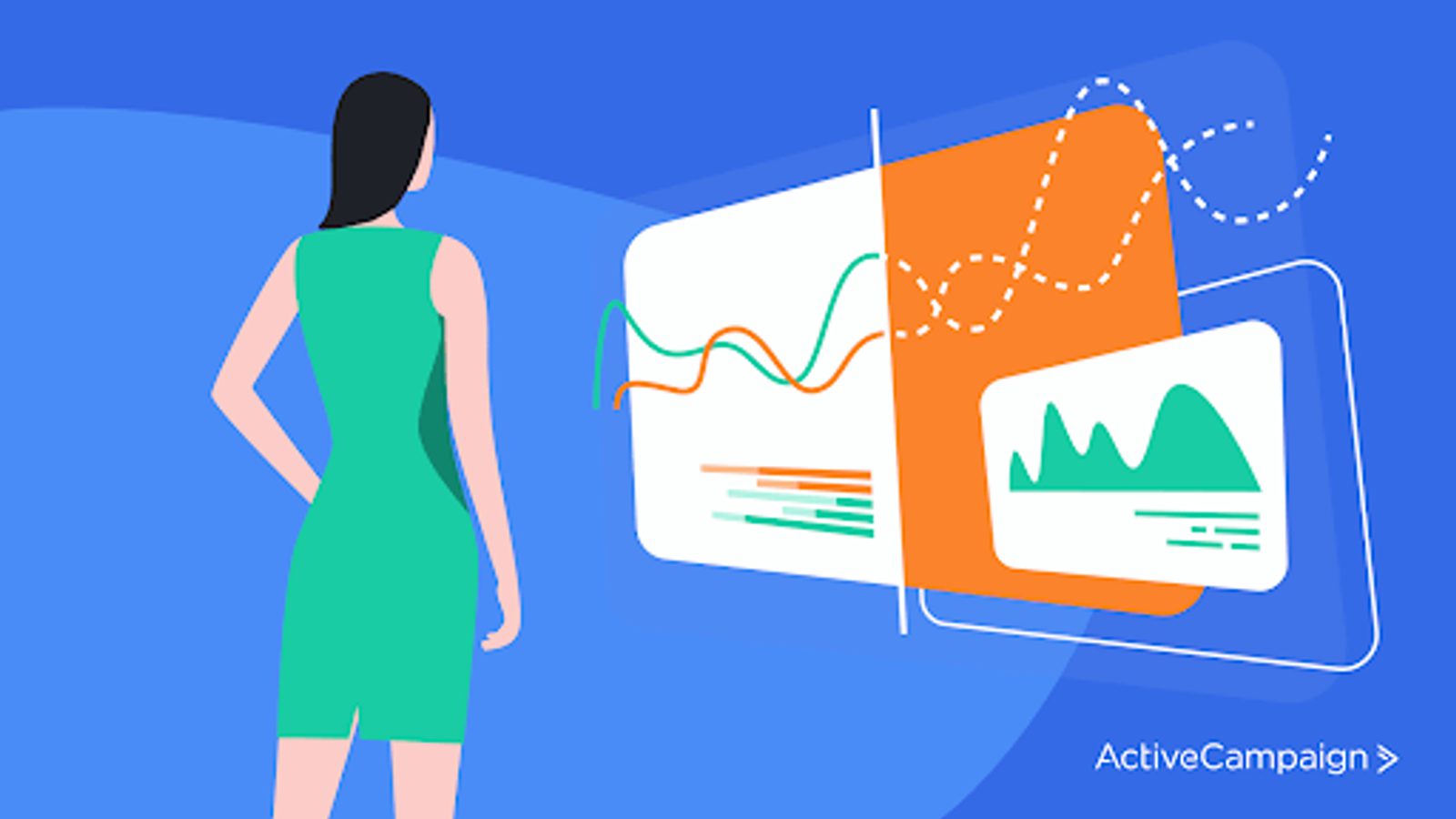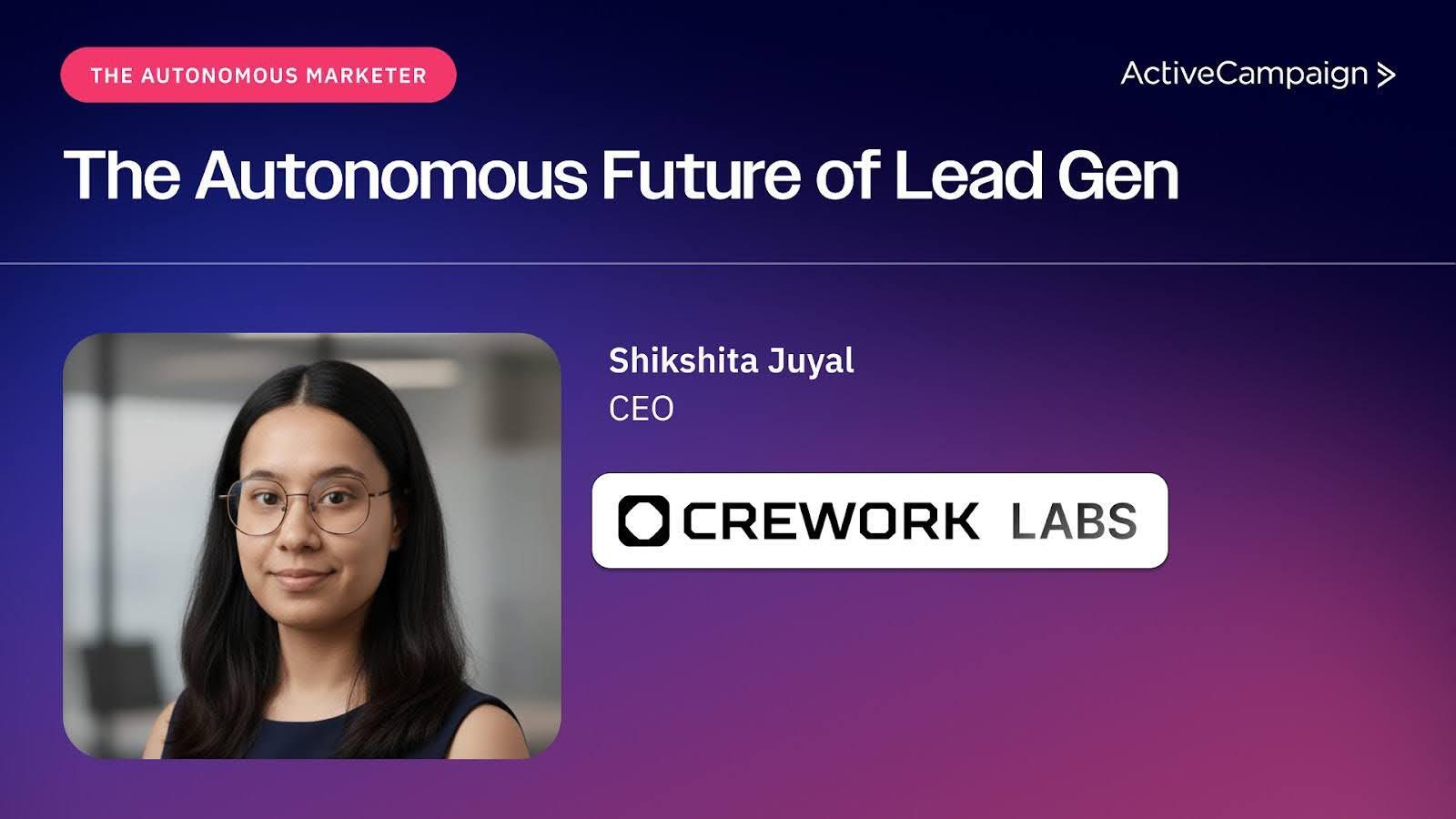Customer data is your most important commodity. Without it, you can’t truly understand your customers' desires and how to meet them.
The marketing world has developed several types of technologies to deal with ever-growing volumes of customer data. Two that are often confused are customer data platforms (CDPs) and data management platforms (DMPs).
They sound similar, but each serves its own purpose in dealing with customer data.
This article will define each one, explain their benefits, show you where both technologies overlap, and cover their differences. By the end of this article, you’ll understand each tool’s purpose and how they complement each other.
Table of Contents:
What is a CDP?
A customer data platform, or CDP, is a type of marketing platform that automatically gathers first-party data—data collected directly from the customer—to create a more cohesive view of individual customers. CDPs also use second-party data, which is data purchased from other sources.

A CDP gathers first-party data throughout the customer’s lifecycle from multiple sources, such as your mobile app, website, social media, and CRM, and aggregates it in one place. It also can share that data with other tools in your tech stack.
As a result, you can increase personalization in your marketing.
A CDP differs from a customer relationship management platform, also known as a CRM, which primarily requires users to manually gather and enter first-party data.
CRMs are generally used by sales teams in customer-facing roles for managing individual relationships, whereas the marketing team would use a CDP to improve their overall marketing strategy.
However, you don’t have to pick one or the other—especially with a CRM like ActiveCampaign. We integrate with many popular CDPs, including Tealium and Rudderstack.
Start Managing Your Customer Data
Benefits of CDPs
CDPs can work well for getting high-quality data quickly. Here are some benefits they offer:
- Gathers first-party data: Third-party cookies are slowly disappearing. This means first-party data may become the best way to understand your customer.
- Collects data in one location: This reduces information siloing, saves time, and streamlines your marketing efforts, especially when implementing an omnichannel strategy.
- Delivers honest data: A customer’s interactions with your brands may provide more honest information than if you surveyed them directly.
- Automatically gathers data throughout the customer lifecycle: Again, this data gathering automation saves you time on data collection.
- Improves personalization: CDPs create concise customer profiles to enhance targeting and messaging.
- Discovers new audience segments: Your CDP may help you uncover hidden customer attributes and segments, helping you tailor your marketing and even create new products or services.
- Improves compliance: CDPs can help you improve compliance and protect customer data. With all the data in one place, it’s easier to keep track of each customer’s privacy preferences.
What is a DMP?
A data management platform, or DMP, is a marketing platform that primarily collects massive, anonymized data sources. That means they mostly use third-party data—such as data that comes from cookies. They also deal with some second-party data.
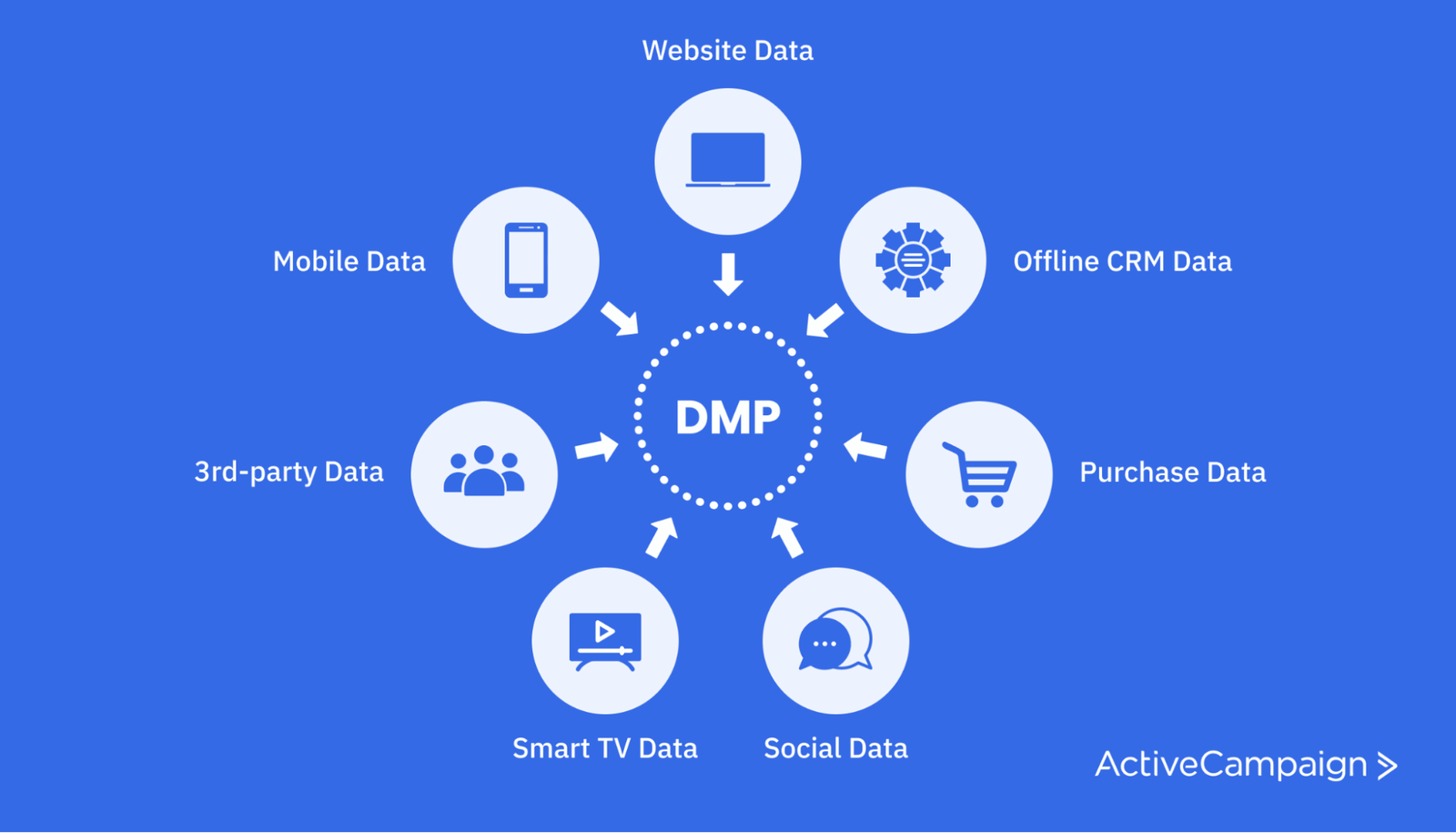
It uses audience data, not personal data. You don’t get individual identifying information about customers, like their names. Instead, you get data such as websites they visited or their interests.
Google Marketing Platform is an excellent example of a DMP. It gathers huge data sets from its users using third-party cookies and anonymizes that data before selling it to businesses to advertise with.
These advertisers don’t get personal information on any customers, but they do have marketing data useful for running ads to audiences with particular attributes.
Benefits of DMPs
DMPs can be immensely useful tools when dealing with large volumes of customer data. They offer some similar benefits to CDPs but in a slightly different manner. Here are some benefits they offer businesses:
- Gather large data sets fast: You can gather a massive amount of data in a short time with a DMP.
- Better audience targeting: Although the data is anonymous, it is quite useful for targeting a specific audience based on certain attributes.
- Improved lead gen: Since you can target specific audiences instead of putting out broad ads, you can bring in more high-quality leads.
- New segment identification: You can look for trends within your third-party data sets and spot new attributes you didn’t know about. This makes creating new marketing and even new products and services easier.
- Budget optimization: With DMPs, you can make sure your ads are only going in front of people who are likely to buy. This cuts your ad budget by potentially increasing conversions for the same amount of advertising.
How are CDPs and DMPs similar?
The most apparent similarity between CDPs and DMPs is that they both let you use data to inform your decision-making—primarily in your marketing campaigns.
Both allow you to store, organize, and manage that data in some way or another. That way, you can find ways to strengthen relationships with customers and improve your marketing messaging.
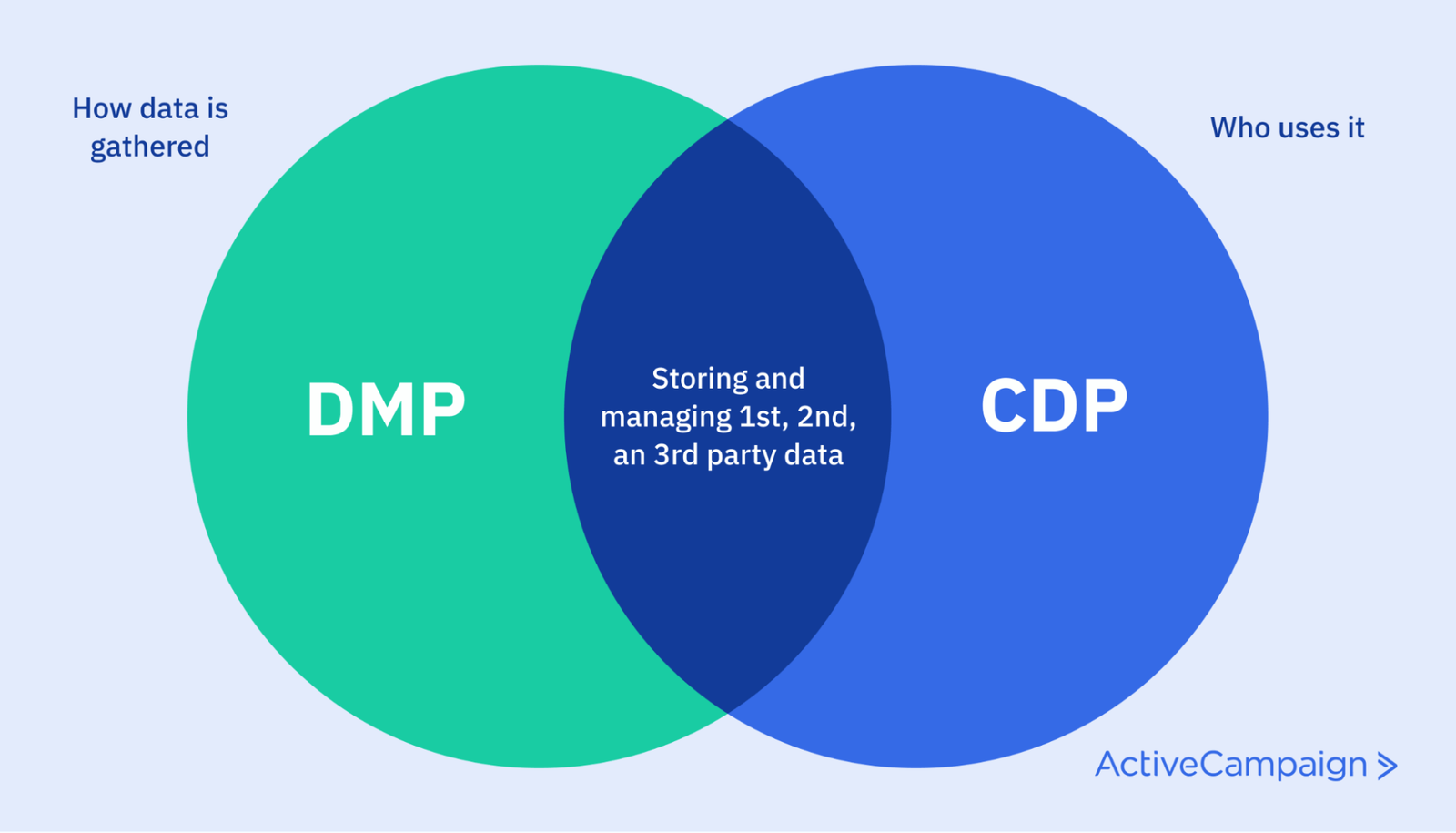
As for the type of data, both are capable of dealing with second-party data. Let’s look at the three main types of data in more detail.
Take your expertise online with FREE plug-and-play webinar templates!
The three types of data
The three main types of data are first-party, second-party, and third-party data.
First-party data comes directly from the customer, and it’s data that you own. This generally comes from your marketing channels and touchpoints.
For example, a customer’s purchase history is an excellent piece of first-party data. Another example is what content formats or subjects see the highest customer engagement from that person.
First-party data can include personally identifiable information (PII). This is any information you can use to uncover a user’s actual identity, like their name, phone number, email address, or mailing address.
Second-party data is first-party data you buy from someone else, usually a trusted partner or non-competing business.
A common example of second-party data is an email list. Many businesses will buy email lists from other businesses in their niche or an adjacent niche and market to those lists.
It’s important to note that you have to be very careful with second-party data. Buying any data without express permission from the people on the list can be illegal. The most common example of this is buying email lists. Even if you purchase one, you must get individual consent from each person on that list before adding them to an email list. If you don’t, you risk your email authority score dropping, or worse, facing legal consequences.
While there are some cases where second-party data can be highly beneficial, such as trading with a partner company where the permission is explicit, we recommend against purchasing data in this way.
Lastly, third-party data comes from a third party in a much more “public” fashion. A third party will collect data from several sources all over the web, then anonymize and sell it to companies that want it.
Currently, third-party cookies are responsible for gathering third-party data. However, Google is supposed to be slowly phasing these out.

How are CDPs and DMPs different?
CDPs and DMPs can both be valuable tools in dealing with customer data. However, they each specialize in different types of data and use that data differently, creating unique use cases for each.
Here are the primary differences between CDPs and DMPs in more detail.
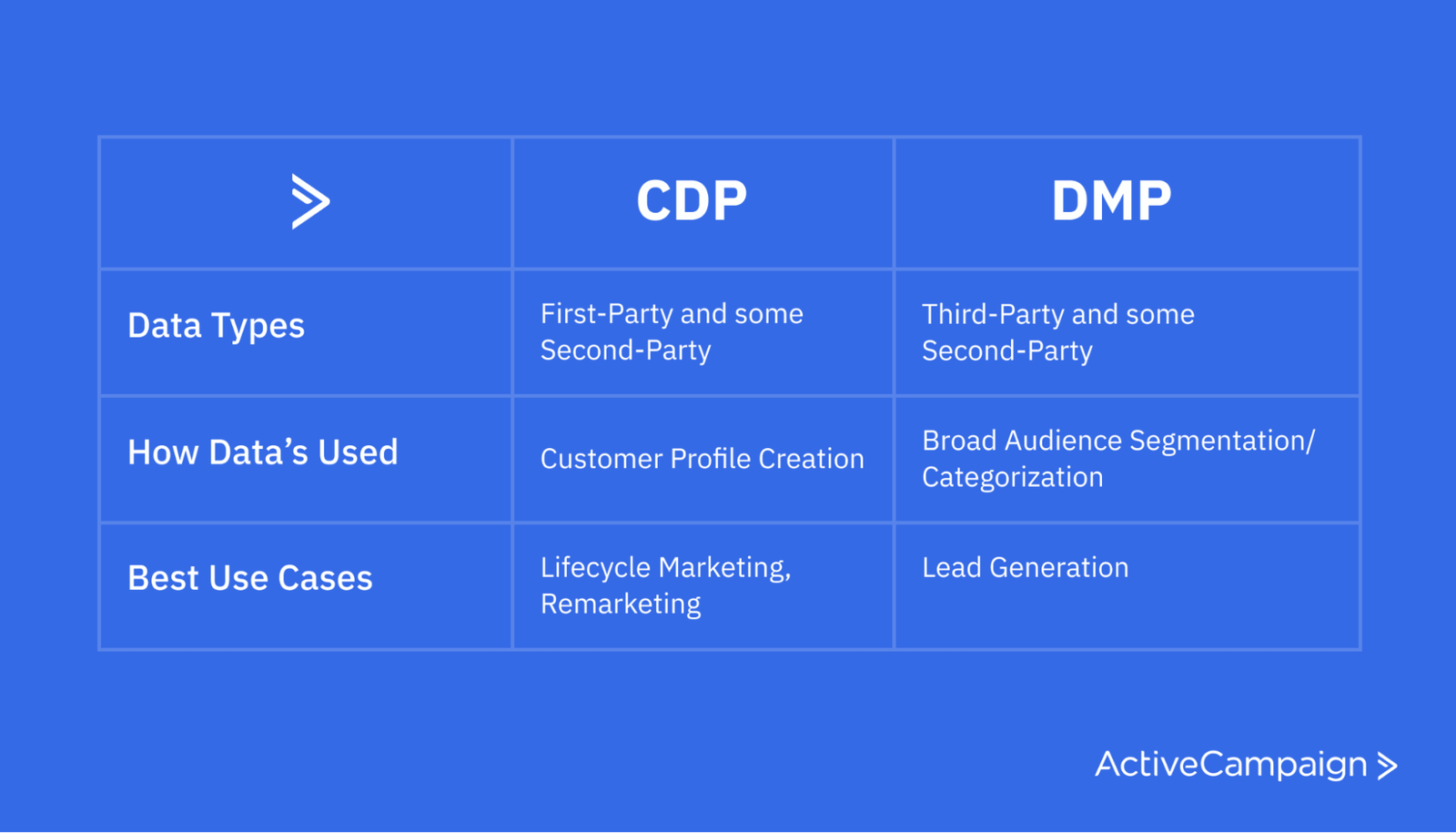
The types of data they gather
Both platforms can use second-party data. After all, you buy that data voluntarily—so any platform that stores data can accommodate it.
That said, this second-party data might look different on each platform. CDPs could attach that information to individual customer profiles within the platform, whereas a DMP would not allow you to identify a particular user with that second-party data.
However, where they differ most in data types is the collection of first-party vs. third-party data.
CDPs primarily use first-party data to build customer profiles. This comes directly from the customer who consents to give you this data through your various brand touchpoints.
As a result, some of the information that CDPs gather is PII.
Generally, CDPs gather this data automatically. They then hold onto this data permanently unless you need to alter or delete it for some reason. For example, a customer’s data might change, or they could request that you delete it.
On the other hand, DMPs use third-party data. The third-party gathers the data from individual users, anonymizes it so you can’t personally identify a particular user, and provides it to you for broader marketing purposes.
DMPs also store data temporarily, unlike CDPs.
How they use the data they gather
Both platforms use the data they gather to help you improve your marketing, but how that looks is different.
CDPs primarily use the data to create individual profiles for each user. They do so through a process called identity resolution, which involves stitching various identifying factors across touchpoints and devices into a single profile.
For example, your CDP might gather a user’s purchase history from your online storefront, content browsing habits from your blog, and social media interactions from your Facebook or LinkedIn page. The platform would then add that to the customer profile.
DMPs don’t build such tailored customer profiles because, again, they don’t use PII. Instead, they arrange data into categories helpful in creating specific audiences and user segments.
Additionally, DMPs come with two data stores—one where all the data is stored in a rougher format and another where you can quickly access a subset of that data. It’s overall less scalable than a CDP.
What use cases they’re built for
Based on their data types, one of the greatest CDP use cases is lifecycle marketing. You can personalize your marketing based on a customer’s habits, guiding them to the next stage in their customer journey.
For example, you might notice your customer reading about a specific subject on your blog. A good CDP could recommend similar blog posts based on their reading habits to keep them engaged.
Then, perhaps they sign up for your email list. Again, you notice their open and click-through patterns on emails covering specific subjects. You can put them into a segment based on this information to ensure they get relevant emails.
Finally, perhaps the customer purchases a product. Now, they have a purchase history in your CDP.
You can send them emails to check in on how things are going with their product, give them tips on how to use it effectively, and eventually upsell them on the “next” product in their customer journey.
DMPs have a much more focused use case—lead generation.
Sure, you can retarget potential customers with DMPs, but you can’t personally identify users as well as you could with a CDP.
As a result, DMPs can be effective tools for top-of-funnel lead generation. You can target audiences based on multiple broad attributes and create compelling, high-ROI lead generation campaigns.
For instance, Facebook Ads offers plenty of ways to build targeted audiences, helping you take advantage of Facebook’s massive user base to test campaigns quickly and generate quality leads.
Do you need a CDP and a DMP?
As you can see, both CDPs and DMPs offer several benefits and uses on their own. But you can combine them to an even greater effect.

For example, imagine you want to expand your current customer base so that you can grow and scale. One way to do this is to target a new segment of customers.
You’d start by testing ad campaigns through a DMP. You’d experiment with different audience segments until you find something that brings in a steady stream of leads that interact with your brand.
Then, your CDP would begin gathering data on how they interact with all of your marketing channels. Now, you can start to divide customers into segments using these interactions and tailor your marketing to each customer.
So which one you need both depends on your current marketing strategy and how you’re prioritizing your budget.
CDPs and DMPs: They both have their place
CDPs and DMPs both have roles in managing your customer data. CDPs use first-party data for more tailored marketing based on an individual user’s profile. On the other hand, DMPs help cast a wider net online when creating targeted ad campaigns.
That said, both of these can be expensive. A CRM like ActiveCampaign can be much cheaper to implement, and you can still leverage the power and personalization capabilities of customer data. Plus, ActiveCampaign packs in plenty of marketing automation features to help you nurture and sell leads on autopilot with personalized messages.

